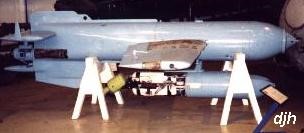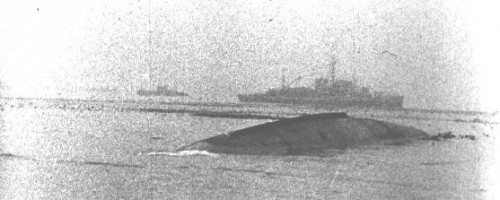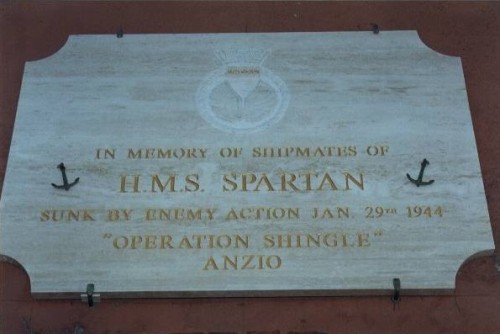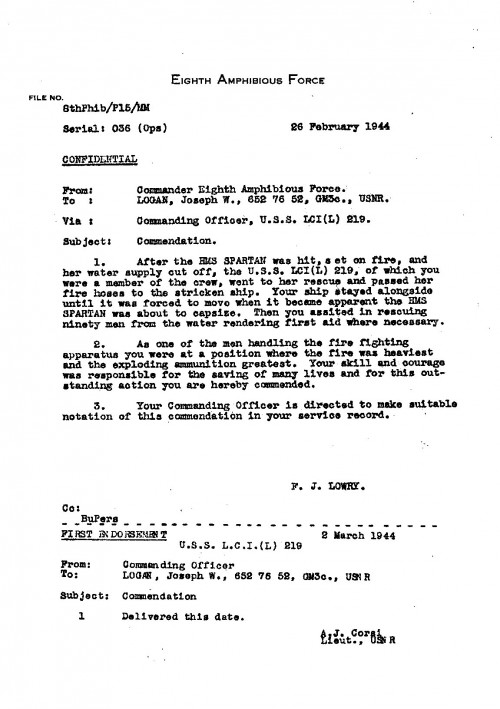The Loss of HMS Spartan 29th January 1944
THE LOSS OF HMS SPARTAN 29th JANUARY 1944
At sunset on 29th January, the Luftwaffe began a glide bomb attack on the ships in Anzio Bay. At the time of this attack, HMS Spartan was anchored providing AA protection for the ships in the vicinity of the beachhead. Smoke had been ordered in the anchorage but was not fully effective owing to the short time it was in operation and the strong breeze. HMS Spartan was making smoke from stem to stern but was not herself covered.
About 18 aircraft approached from the north and circling over land, delivered a beam attack against the ships that were silhouetted against the afterglow. The timing of the attack prohibited the aircraft from being sighted except by very few witnesses, and radar was ineffective owing to land echoes. By the time the warning had been received and HMS Spartan and other ships had opened fire in the general direction of the attack, six bombs were already approaching the anchorage, most of them falling into the water.
Shortly afterwards, at approximately 17:56, another glider bomb (radio-controlled Henschel Hs 293) was seen approaching the starboard side of the ship. This bomb was engaged by close range anti-aircraft fire; it was first thought likely to miss astern but is reported to have altered course during the final stage of its approach.
The bomb struck the ship at the after end of “B” funnel casing, started a heavy fire in the vicinity, the projectile passed through the ship and exploded high up on the port side of the main watertight sub-division containing “B” Boiler Room.
The main mast collapsed and boiler rooms were flooded. Steam and electrical power failed, a serious fire developed and the ship heeled over to port. Thus HMS Spartan was immobilized. About an hour after being hit, Spartan had to be abandoned in the dark, and 10 minutes later she settled on her beam-ends in about 25–30 ft (7.6–9.1 m) of water.
Five officers and 41 enlisted men were posted killed or missing presumed killed, and 42 enlisted men were wounded. Ron Douglas survived together with Acting Lieutenant J.S. Mackonochie, engineer.
The following extract is from Ronald Sired’s book, “Enemy Engaged” (published by William Kimber & Co. London, 1957, page 184) who was serving onboard HMS Laforey.
Just about this time I spotted a radio controlled-rocket bomb coming from a Do.217, and heading straight for Spartan. All our close-range weapons were directed towards the bomb, but it was travelling too fast for our fire to be accurate. I was able to see its red tail as it made for Spartan some 400 yards away. I watched helplessly as the bomb fell. I saw a bright flash as it exploded amidships, between the funnels, and a pillar of flame shot into the evening sky, momentarily lighting up Spartan. Serious fires were started and the Spartan quickly listed to port. By 1800 (this time must be incorrect as it does not fit with the Admiralty report) she was badly ablaze and, as the flames grew higher, I saw men dashing along her heeling decks with hoses and other fire fighting equipment. Other men dived over the side into the water.
Laforey moved closer to the strickened ship, which had listed further to port. Already her stern was below water. The after turret glowed red hot and sultry red flames reflected from gathering clouds. Laforey lowered both whalers and the motor-boat to pick up survivors. HMS Barndale was also standing close by, ready to go alongside Spartan at first opportunity to take off the wounded menbers of her ship’s company.
By 1840, the Spartan had listed some 70 degrees to port and I saw loose gear from her upper deck fall into the sea. Most of her ship’s company had jumped overboard and were being picked up by small craft. Her list increased and her fires died down as water flooded her compartments. From across the still waters came cries of men as they struggled in the oil-covered waters. The faint glow of torches flickered here and there as boats made their way to them.
By 1910, Spartan lay almost on her beam-ends and the water was lapping around her bridge. There were still a few intrepid sailors aboard her, helping wounded men to the boats alongside. Our motor-boat came alongside and took off her skipper, Captain McLaughlin. I saw a small cockle shell of a boat, a dinghy, containing one sailor, bobbing up and down close to the compass platform of the cruiser, searching for survivors. It was a queer sensation to watch the sea claim this once proud ship. The sea lapped over the upper-deck, which was now practically vertical and facing towards me.
By 1930, our scrambling nets which had been lowered over the side were swarming with oil-soaked survivors, and the first-aid and repair parties assisted them as they climbed inboard. There was considerable activity on board as the damage control parties dashed away for rum and blankets. Most of our ship remained closed-up in case of further attacks, but there were none.
By 1940, Spartan’s bridge and upperworks were underwater and I watched her starboard bilge keel appear as she slowly rolled over. The sea broke over her keel and her rudders and propellers were clearly visible as she sank from sight. By 2000 Spartan was no more. I had watched the foaming waters surge over her keel as she vanished, (In reality it was probably the darkness and not the sea that swallowed Spartan for, in fact, the ship’s keel remained visible).
The task of searching for her crew continued in the darkness and, as our mess-decks were crowded with survivors we moved away from the scene. Landing craft came alongside Laforey to take off Spartan’s survivors and at 2030, with the destroyer Loyal, we left for a night patrol at sea.
Joseph Logan, Gunners Mate, on board LCIL 219, together with his shipmates also assisted HMS Spartan. As Joseph described it, “LCI 219 quickly pulled alongside the Spartan in an effort to assist fighting the fires. I was manning one of the hoses. The landing ramps of the LCI were lowered down to the water surface to assist pulling the sailors out of the water. Other crew members of LCI 219 helped the Spartan sailors up the ramps. I seem to remember there were about 75 men pulled out of the water onto LCI 219. First aid was provided as needed.”. His son states that his father and other crew members used artificial respiration methods that he learned in the Boy Scouts to aid some of the British sailors.






I have just read the various communications above and will remember you all when I next see the plaque to HMS Spartan on the wall in the corner of the port at Anzio. Close by is one to the fallen of the Duke of Wellington’s Regiment, which included my father. I was present when this was unveiled by Duke’s veteran, John Young in 2004.
My great grandad Joseph (joe) schofield survived the tradgedy and I want to research more. I still hold his medals close to me all the time.can anyone help
Where could I find my grandfathers records
4i can remember your Dad Johnnie Joseph from the Spartan survivors we used to meet at the Portland hotel in Birmingham at the end of January. There were about 20 survivors attended. My dad Geoff Smith managed to raise the money to have a plaque in Anzio where we are right now for the 75th anniversary .
Well done, Chrissy.
I have just seen your posting of Jan 21st 2019.
Thank you for your efforts re. the 75th anniversary tribute.
My late father, Howell Harris was a survivor, and I met with your dad, Geoff, on several occasions, at Birmingham.
It appears that my second cousin Able Seaman James Sanders, born in Darwen Lancashire, was one of those lost in the sinking of Spartan and I presume his body was never recovered. He was 22. His name is commemorated on the Portsmouth memorial.
My late grandfather, Ronald Mairs,DLX 571180, survived the sinking of HMS Spartan. He was the Captains Steward. He was in one of the main turrets when the ship was hit working as a gun loader I think. I had many conversations with him about his time on the ship, I think he appreciated my interest. His account of the sinking was very dramatic. He almost didn’t get out and would have drowned if it hadn’t been for a strong shipmate (a marine I think he said) pulling him out by the scruff of his neck! After the ship went down, he was taken to Egypt on a hospital ship.
I am trying to find out about an uncle I never knew. I know he was posted to fight in the battle of Anzio and I remember my grandmother telling me he was on a ship that was bombed and it sank. I can only think that the ship must have been HMS Spartan. His name was Thomas Savage and although this is a very long shot, I wonder if any surviving relatives have a list of the men who died in that attack? Thanks for your wonderful research so far.
Try this. http://home.aut.ac.nz/staff/dhughes/mairangi.html
My grandad was Joe schofield. He was a stoker on the spartan. Any info would be great
https://www.lancashiretelegraph.co.uk/opinion/1793792.remember_all_the_fallen_when_you_buy_a_poppy/
RAYMOND BOMBY (died 2009)survived the sinking of the Spartan. In his account he writes about having been picked from the sea by HMS O’Rien but I can find no such ship. Any help/suggestions?
My father William Charles Horbury was a radar plot on board .Dad never spoke about the war but did once tell me he was on deck and his best pal was crushed under a gun turret asked my dad to get his fags out of his top pocket give him one and keep the rest and died in front of him. I know his parents got a telegram listing him as missing in action but never did dad want to speak of that time
Hi there – my Father-in-law ( George Roycroft ) was on the Spartan when it sunk. He was in the Royal Marines and couldn’t swim! He was a musician. I can’t find any record of his being on this boat. Please can someone point me in the right direction? He passed away a few years ago but the info would be appreciated by his family. Many thanks. Valerie
Thinking about my father in law. I know he changed his surname at some stage from Bolger/Bulger to Roycroft so unsure which name he was in the Marines with.